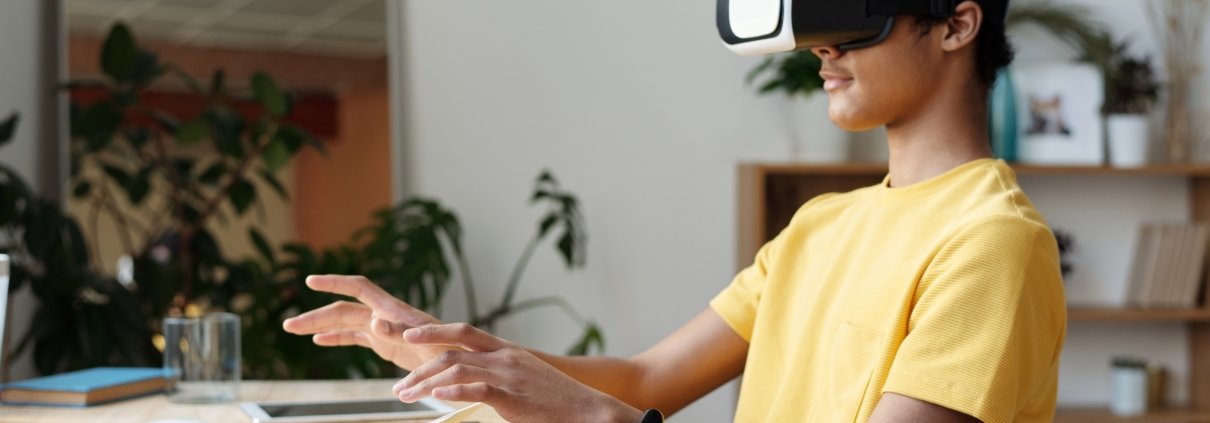Hello, this is virtual me – how to prepare for business interviews in VR
There is a lot of talk about Virtual Reality (VR) adoption in vertical media channels. The topic has been circling the media for the past 5 years, yet only a handful of organisations today truly employ VR technology for everyday business meetings or social gatherings.
I first encountered VR applications when I worked with Unity Technologies. I was in awe of the ability to create multiple-use projects in Augmented Reality (AR) — around that time the technology became more known to the masses due to the popularity of the mobile game Pokémon Go. While I never had a deep interest in computer games, I was excited to see how varied AR projects can be used.
At the same time, the Unity platform was being widely used to create AR and VR applications — I saw the first steps of how the automotive industry keenly adopted VR for designing their cars by immersing themselves into the virtual studio and exploring new designs.
I am lucky enough to work for a progressive communications agency that looks further ahead and is a keen adopter of VR in business. Yes, VR use is not normalised just yet, but it is important to understand how the technology works — if not for practical use, at least for curious exploration. At Tyto, we are in the early and elevated days where we have just started to use VR for business and social bonding. A few of our clients also use VR within their companies. This provided us with the knowledge on how to use this technology — and we really understand how frustrating or anxious it can be if you are still getting used to this immersive reality. Our Virtual Reality project is just the first one of Tyto Labs, our research and development arm focused on exploring new technologies, channels, services and methodologies to enhance the way Tyto operates and the services we offer.
I cannot stress enough that this is very novel, but there is already a publication that takes VR interviews such as UploadVR. On a similar note, independent YouTubers are using VR to interview people with interesting life stories, while career coaches and companies prepare people for interviews via the VR experience, and recently Microsoft launched a mixed reality platform called Mesh which long-distance co-workers can use to collaborate.
Both AR and VR enable people to have a more personalised and immersive experience, something that video conferencing cannot truly fulfil. It is especially prominent in the current circumstances. People were forced to reshuffle work models to remote due to the pandemic, but it is painfully clear to most of us how video conferencing can be demanding and cause fatigue.
While remote work is not a new concept for Tyto, we played with the idea of what it would be to use VR in the interview process. Recently, we had our first client and media interview in VR. It proved to be very successful. Despite the child-like explorative excitement, it enabled people to join together despite their location — some people were from various USA states, while others connected from their home offices in European countries. It all felt very natural as controllers allowed participants to gesticulate and headsets showed head movements and nods.
From my personal experience, I would like to share a few key tips that each of us must consider if we are having a formal meeting in VR, whether it is a meeting with the client or a potential employer.
Five tips on how to prepare for the work-related interview in VR
- Figure out your tech – allow yourself to really get comfortable with your headset. It can be stressful enough to speak with a client or potential employer in the real world, and no one would like technology to be another reason to feel uncomfortable. Charge your headset ahead of time, familiarise yourself with the app where the meeting will be held, and check how to move yourself around in the virtual room. It might be helpful to ask the interviewer if you could join the meeting 15 minutes in advance to set yourself up.
- Dress for success – if you are going to a meeting with a current or future business partner, treat it as a professional interview. Double-check what your avatar looks like and dress professionally. A sleeveless shirt is not the most professional look, even if it is the only outfit in the colour you love.
- Body language – as in real life, so in VR, the best speakers will use all the tools they have to portray their thoughts. Use your controllers as you would use your hands. Gesticulation will help you to express your point in a livelier manner and empathic head movements will help to ease the initial tension between you and another person. Body language will also help to connect via non-verbal cues. In management literature, invisible realities are widely discussed, and certain body language techniques are suggested to empathise and familiarise with the collocutor. Use your VR tools to your advantage.
- Be vocal – it can be awkward in the first meeting, so prepare a few ice breaker topics while everyone gets accommodated. Rehearsed small talk will make you feel at ease and calm until the real conversation starts.
- Enjoy it – it is a fresh playground for everyone, so do not be shy. Open up about how you feel excited or nervous but keen to explore this new reality. Honesty and a warm attitude can be a good ice breaker to start the conversation.
Image ©Julia M Cameron, pexels.com


 RSF
RSF